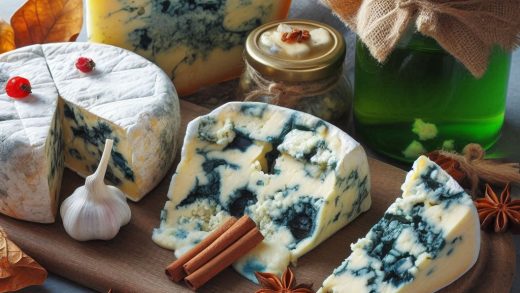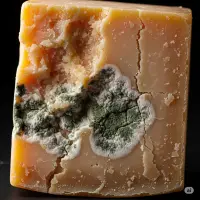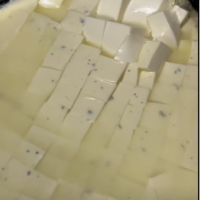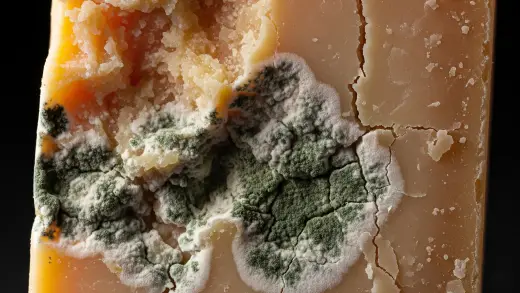Yes, the rind of Camembert cheese is generally edible and considered safe to eat, according to reputable sources like Président Cheese and The Cheese Lover.
Ever wondered about that soft, white blanket hugging your creamy Camembert cheese? You’re not alone! This famous French cheese is known for its special outside layer, called the rind.
So, can you actually eat it? Generally, the answer is a happy “yes!” That fuzzy white coat is a sign of a healthy, ripening cheese and it adds a unique touch to the whole experience.
But hold on a second, there’s a bit more to this cheesy tale. Eating the rind can change the way the Camembert tastes and feels in your mouth. It often has a more earthy, mushroomy flavor than the smooth inside. The texture can also be a little firmer and sometimes a bit chewy.
Besides the interesting taste and feel, the rind is actually alive with good stuff! It contains special molds that help the cheese ripen and develop its wonderful flavor. Some folks even believe these molds can be good for your tummy.
However, just like with any food, there are a few things to keep in mind. If you see any spots that are not white and fuzzy – like blue, green, or pink – it’s best to skip eating the rind in those areas. Also, if the cheese smells really strongly of ammonia, that’s a sign it might be past its prime.
So, go ahead and be a little adventurous with your Camembert! Try a bite with the rind and see what you think. It’s all part of the delicious journey of exploring this amazing cheese.
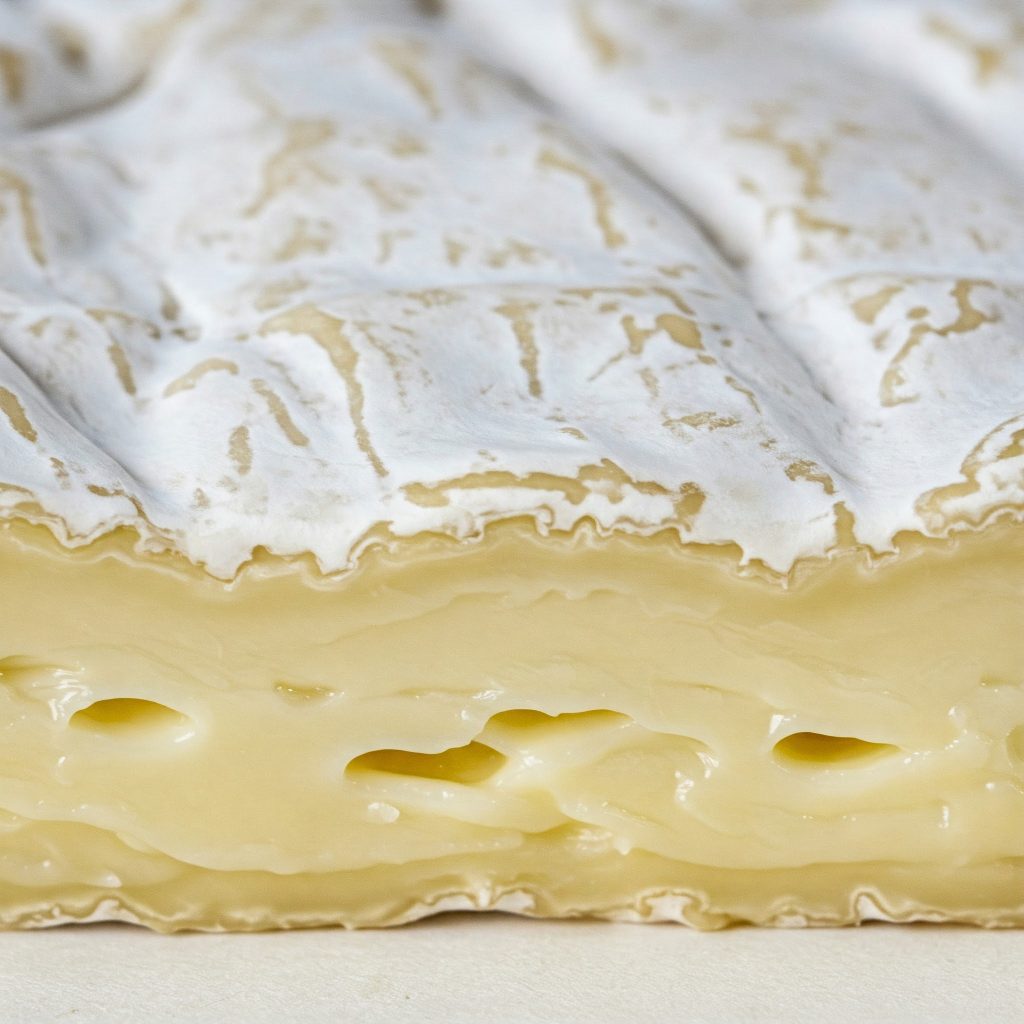
Can You Eat The Skin Of Camembert Cheese?
Yes, the rind of Camembert cheese is absolutely edible and, in fact, is meant to be eaten!
Here’s why:
Flavor Enhancement
The rind contributes to the overall flavor profile of the cheese, often adding a more intense, earthy, or mushroomy note that complements the creamy interior.
Texture Contrast
The slightly firmer texture of the rind provides a pleasant contrast to the soft, melty inside of the Camembert.
Traditional Consumption
In France, where Camembert originated, it is typically eaten with the rind. Removing it might even be seen as unusual.
Safety
The white, bloomy rind is formed by a harmless mold called Penicillium candidum or similar varieties, which is safe for consumption.
How to enjoy it
- Bring to room temperature: Like most cheeses, Camembert’s flavor and texture are best enjoyed when it’s not straight out of the refrigerator. Let it sit at room temperature for about 30 minutes before serving.
- Eat it whole: Cut the Camembert into wedges and enjoy each piece with the rind. This allows you to experience the full flavor and textural combination.
- Try it baked: Baked Camembert becomes wonderfully gooey, and the rind provides a slightly chewy edge.
If you try the rind and don’t enjoy the taste or texture, you can certainly cut it off and eat just the creamy interior. However, you might be missing out on a key part of the Camembert experience.
What is Camembert Rind Made Of?
That lovely, soft, white coat on your Camembert is actually a bloomy rind, and it’s all thanks to a special kind of mold called Penicillium camemberti.
Think of it like a delicate blanket that grows on the outside of the cheese as it ages. It often looks soft and white, sometimes with a slightly fuzzy feel.
This rind isn’t just for looks, though! It plays a super important role in how the Camembert matures and develops its unique and delicious flavor.
As the cheese ripens from the outside in, the Penicillium camemberti works its magic, breaking down fats and proteins inside the cheese. This process is what gives Camembert its smooth, creamy texture and complex taste.
It’s important to know that this natural, edible rind is totally different from the coatings you might find on other cheeses, like a hard wax or a piece of cloth. Those kinds of rinds are there to protect the cheese and aren’t meant to be eaten.
The Taste and Texture of Camembert Rind
When you take a bite of Camembert with the rind, you might notice a more earthy or mushroomy flavor compared to the rich, buttery inside. Some people even describe it as having a slightly tangy or nutty note.
Interestingly, the taste of the rind can change depending on how ripe the cheese is. A younger Camembert might have a milder rind, while a more mature one will often have a stronger, more pronounced flavor.
The texture of the rind is also different from the creamy interior. It’s usually a bit firmer and can sometimes feel slightly chewy on your tongue. This contrast in texture between the soft inside and the slightly more resilient rind is part of what makes eating Camembert so enjoyable.
The best way to figure out if you like the rind is to try it for yourself! Take a small piece of Camembert and taste it both with and without the rind. That way, you can decide which way you prefer to enjoy this fantastic cheese.
What are the Benefits of Eating Camembert Rind?
You can eat the Camembert rind.
It makes the cheese taste even better for you, giving it an earthier, mushroomy flavor. You also get a different feel in your mouth because the rind is a bit firmer than the soft inside.
People have always eaten it this way, especially where Camembert comes from. The white stuff on the outside is safe for you to eat.
How you can enjoy it
- Let it sit out a bit before you eat it so it tastes better.
- Just cut it into pieces and eat the whole thing, rind and all. This is the best way for you to taste everything together.
- You can even bake it, and the rind gets a little chewy.
Indeed, if you try the rind and you don’t like it, you don’t have to eat it. But you might find you like it and get more out of your cheese!
Potential Concerns or When to Avoid the Rind
While the Camembert rind is generally safe and enjoyable to eat, there are a few situations where you might want to avoid it:
If you see signs of spoilage
Look out for any mold that isn’t the typical white, downy rind. Discard the cheese if you see dark spots, blue or green mold, or a slimy texture on the rind.
If it smells strongly of ammonia
A slight mushroomy or earthy smell is normal for Camembert, but a strong ammonia odor indicates that the cheese is overripe and the rind might not be pleasant to eat.
If the rind has separated significantly from the cheese
While not necessarily harmful, a detached rind can sometimes have a different texture or taste that you might not enjoy.
If you have a strong dislike for the texture or taste
Ultimately, eating the rind is a matter of personal preference. If you’ve tried it and don’t like it, feel free to leave it.
During pregnancy
While the risk is low with pasteurized cheeses, some health professionals advise pregnant individuals to avoid soft cheeses with rinds due to a potential risk of listeria. If you are pregnant, it’s best to consult with your doctor or midwife for personalized advice.
In simple terms, trust your senses
If the rind looks or smells off, it’s best to avoid it. Otherwise, feel free to enjoy the rind as part of the delicious Camembert experience!
How to Best Enjoy Camembert with the Rind?
To really enjoy Camembert with the rind, here are a few tips for you:
Let it Warm Up
Take the Camembert out of the fridge about 30 minutes before you plan to eat it. When it’s at room temperature, the flavors will be more pronounced, and the inside will be wonderfully soft and gooey. This also helps the rind soften a little.
Eat it in Wedges
The classic way is to cut the Camembert into wedges, making sure each piece has some of the rind. This way, you get the taste and texture of both the creamy inside and the more flavorful rind in every bite.
Pair it Simply
Camembert is delicious on its own, but simple pairings can enhance your experience. Try it with:
- Crackers or Baguette: Their neutral flavor and slight crunch won’t overpower the cheese.
- Fresh Fruit: Apples, pears, or grapes offer a lovely sweetness that contrasts with the richness of the cheese.
- Nuts: Walnuts or almonds add a bit of texture and earthiness.
- A drizzle of honey or a dollop of fig jam: These sweet additions can complement the savory cheese beautifully.
Don’t Be Afraid of the Rind’s Flavor
Take a moment to notice the taste of the rind. It might be a little earthy, nutty, or even have a hint of mushroom. This is part of what makes Camembert special.
Try Baking It
Baking Camembert makes the inside incredibly melty, and the rind becomes a warm, slightly chewy edge. You can drizzle it with olive oil, herbs, or garlic before baking. Serve it with crusty bread for dipping.
Consider Wine Pairings
A crisp, dry white wine like Sauvignon Blanc or a light-bodied red like Beaujolais can be a great match for Camembert.
Basically, take your time, let the cheese come to room temperature, and try eating it in a way that lets you experience both the creamy inside and the flavorful rind together. You might find it’s a whole new level of deliciousness!
Conclusion
So, the answer to that initial question is a resounding yes – the rind of Camembert is generally safe and actually intended to be eaten! It adds a unique flavor and texture dimension to the cheese and is part of what makes Camembert so special.
We encourage you to be a little adventurous the next time you have Camembert. Take a bite with the rind and see what you think. You might just discover a new favorite part of this classic cheese!
Do you eat the rind of your Camembert? Share your thoughts and experiences in the comments below!


